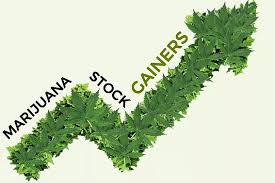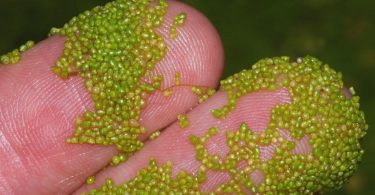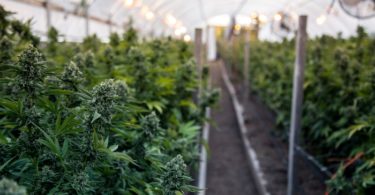The marijuana industry has overcome some impressive hurdles in recent years. In the United States, two-thirds of all Americans now favor legalizing recreational weed, up from a mere 25% a quarter of a century ago. Additionally, after zero states had given the green light to medical or recreational weed as of 1995, 33 U.S. states now have medical cannabis laws on their books, along with 10 states that also allow recreational consumption.
Meanwhile, in Canada, adult-use cannabis is now legal, ending nine decades of recreational prohibition. Whatever barriers have been put up to stop the expansion of the pot industry are slowly but surely being toppled.

Image source: Getty Images.
Listing on the NYSE or Nasdaq comes with perks
The latest of these barriers being challenged is that of marijuana stocks uplisting from the over-the-counter (OTC) exchange to either the New York Stock Exchange (NYSE) or Nasdaq. Since February 2018, eight of the 11 pot stocks that now list their common stock on either the NYSE or Nasdaq have uplisted from the OTC exchange.
Moving from the more under-the-radar OTC exchange to a more reputable exchange like the NYSE or Nasdaq comes with a number of perks. Namely, it means added daily trading volume, improved liquidity, reduced volatility, and the added legitimacy of being listed side by side with time-tested businesses. More pot stocks than not have seen their share prices gallop higher in anticipation of, and after, listing on either of these two major U.S. exchanges.
Perhaps even more important is the fact that being listed on a major exchange means Wall Street is more likely to pay attention to pot stocks, and maybe even make an investment in them. Wall Street investment firms typically don’t invest in OTC-listed stocks, or even offer coverage. By moving to the NYSE or Nasdaq, it’s a means of rolling out the red carpet for institutional investors.
These three pot stocks could be next to uplist
With 11 marijuana stocks already listed on primetime exchanges, but far more barred from making the move, here are three currently OTC-listed stocks that are ready to make the move in 2019.

Image source: Getty Images.
Charlotte’s Web Holdings
The OTC-listed marijuana stock with the absolute best pedigree to uplist is hemp-oil and hemp-derived cannabidiol (CBD) products manufacturer and distributor Charlotte’s Web Holdings (NASDAQOTH: CWBHF).
For a long time, hemp plants and cannabis plants were indistinguishable by federal law in the U.S., which meant that laws that applied to cannabis also applied to hemp. As a result, since neither the NYSE nor Nasdaq will allow companies that directly touch marijuana in the U.S. to list their shares, Charlotte’s Web was pretty much forced to stay in OTC-exchange purgatory.
However, this all changed in December when President Trump signed the Farm Bill into law. The Farm Bill legalized the industrial production of hemp and hemp-derived derivatives, such as CBD, the nonpsychoactive cannabinoid best known for its perceived medical benefits. With hemp no longer tossed under the umbrella definition of a “cannabis plant” by the federal government, it’s created a clear pathway by which Charlotte’s Web can uplist to either major exchange.
Charlotte’s Web certainly appears to meet the criteria for uplisting, with a $1.4 billion market cap, a healthy share price of more than $14, and reasonably strong average trading volume of 367,000 shares a day. The company’s product push into more than 6,000 retail doors has also led to consistent profitability, demonstrating the long-term survivability of its business model. Moving to either the NYSE or Nasdaq would greatly improve the company’s visibility with investors.

Image source: Getty Images.
Flowr Corp.
Another pot stock that’s a sure thing to move from the OTC exchange to the Nasdaq in 2019 is mid-tier cannabis grower Flowr Corporation (NASDAQOTH: FLWPF). I specifically say “sure thing” here because the company had already filed 40-F paperworkwith the Securities and Exchange Commission to uplist, and was officially granted approval this past Thursday. However, no specific date has been set for when the company will begin trading on the Nasdaq Exchange under the symbol “FLWR.”
Unlike most marijuana growers in Canada, Flowr is a bit different — but in a good way. It’s pretty much the only grower that delivered an increase in average selling price per gram of dried cannabis in its most recent quarter, despite the fact that it produced only 280 kilos. That’s because Flowr is focused on an extremely niche part of the consumer market: ultra-premium dried flower and derivatives. Whereas most growers are producing discount or average quality cannabis, few if any are delivering higher-priced, higher-margin pot strains quite like Flowr. Thus, even with only 50,000 kilos of ultra-premium pot expected at peak production, Flowr’s margins should be among the best in the industry.
Speaking of margins, Flowr’s use of genetics, and its research partnership with Scotts Miracle-Gro, could push its industry-leading yield even higher. Currently expected to produce 300 grams per square foot, this partnership may push yields to as high as 450 grams per square foot. By comparison, the industry tends to produce at an average rate of 100 grams per square foot.
This uplisting for Flowr is well deserved, and it should help substantially boost its trading volume, which stands at only 110,000 shares daily on the OTC exchange.

Image source: Getty Images.
The Green Organic Dutchman
With Flowr a lock to uplist, and Charlotte’s Web a veritable lock if and when it actually files its paperwork to make the move, the only marijuana stock left with the proper credentials to uplist that doesn’t have cannabis operations in the United States is The Green Organic Dutchman (NASDAQOTH: TGODF).
The Green Organic Dutchman, or TGOD as the company is also known, projects to be one of the five largest growers in Canada by peak production. Having long forecast 195,000 kilos of yearly output, TGOD somewhat recently upped its peak annual yield to 219,000 kilos following design and engineering updates at its facilities,
But it’s not The Green Organic Dutchman’s aggregate output that’ll likely have investors considering this company for investment. Rather, it’s TGOD’s push into cannabis derivatives in the Canadian market. The company announced last year that it would be setting aside about 40,000 kilogram-equivalents of production for the development of edibles and nonalcoholic cannabis-infused beverages. These derivatives tend to be a considerably higher-margin product than dried cannabis flower, and they (along with vapes, topicals, and other consumption forms) will be getting the green light for sale by Health Canada by this coming October.
At a market cap of $827 million, and with sufficient capital on its balance sheet, TGOD would likely meet the uplisting requirements for the Nasdaq. The only potential hiccup would be the company’s $3 share price. The Nasdaq has a minimum initial listing price requirement of $4, which would mean a rally, or some form of modest reverse split, may be needed before TGOD can apply to make the jump.
More at: Yahoo Finance






